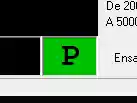Testing with Losses
You can watch the video tutorial on how to measure with Losses (spanish)
WHEEL POWER
In chassis dynos (rollers) the system measures the power that reaches the wheel. In this type of dyno, it is impossible to measure the power at the engine. The indicated engine power is always an estimate. In some software, this estimate is made by adding a percentage to the measured power, which is incorrect.
To estimate the engine power, Accudyno software works with the measurement in coastdown (in neutral). In order to achieve this, it is necessary to carry out the losses measurement. It consists of measuring the braking produced by the wheel and transmission power losses.
These losses vary with speed, therefore it is necessary to consider the value at each RPM. The system adds the measured wheel power and the losses power at each RPM to obtain the engine power, or more accurate, its estimate. So that:
Estimated Engine Power = Measured Wheel Power + Measured Losses Power
It is important to clarify that if the coastdown test has not been carried out, the indicated engine power will be equal to the wheel power.
Losses Power Test
On roller dynos, it is possible to perform a coastdown test. This test is always carried out just after doing a power test, after having reached the maximum RPM.
The coastdown will measure an approximation of the power losses that occur during the power test and add these losses to the wheel power.
- Tick the option
Measure Losses during Coastdown. - Carry out the power test, and when reaching the maximum RPM, switch the vehicle to
NEUTRAL. - Let the vehicle decelerate on its own, without pressing the vehicle brake or the roller brake.
- Do not get off the vehicle, since the weight of the driver affects the result.
- When the RPM reaches the starting RPM, the test will end.
ENGINE BRAKING
The coastdown test must be performed in NEUTRAL. It is not possible to do this by letting off the throttle as that would cause engine braking and result in excessively high power.
CLUTCH DISENGAGEMENT
If the clutch does not fully disengage the engine during the coastdown test, partial engine braking will occur during the test and this will result in very high losses power. In the event that this occurs, the losses test will not be valid and, consequently, the engine power will not be valid either.
In motorcycle engines, it is typical that the clutch does not disengage 100%, so we don´t recommend performing a losses test and measuring only the wheel power. A practical way to know if the clutch is completely disengaging is to accelerate the engine suddenly during the coastdown test at a certain known RPM, for example in the middle of the test. If the clutch disengages, the power loss graph will remain unchanged, but if the clutch is rubbing, we will see a spike at that RPM where it revved up.
-
Once the power test with losses is finished, we can see the results in
Reportor inGraph. To see the results we recommend activating these channels: -
Wheel Power:Power at the wheel, climatically corrected. It is the power that is actually measured on the roller. Losses Power:Power at the wheel measured during the deceleration test. It is the coastdown braking power.Corrected Power:Climatically corrected engine power. It is the result of the sum of the other two powers.
Can I measure losses in vehicles with automatic gearbox?
Due to the characteristics of the coastdown test, it is not possible to carry it out on vehicles with an automatic gearbox that do not allow switching from the test gear to neutral.
Losses Power Test

Once the test with losses has been carried out, you will notice that a letter P appears in green under the tachometer. This indicates that there is losses power loaded into memory and those losses will be applied to all tests we do from now on.
The advantage of this is that it will not be necessary to retest for losses on each power run. The loss from the losses test is reused over and over again.
To remove those losses and measure the wheel power, you can do it in the OptionsLossesRemove Losses menu.
TIRE WARM-UP
Losses depend on tire pressure. At lower pressure, there will be more losses since there is more deformation of the wheel and that consumes energy. The temperature of the wheels causes the air pressure to change. The more heating, the more pressure there will be.
For this reason, when we test losses, if we measure with cold tires we will have more losses power than if we measure with hot tyres. For example the same car on a roller can have a 20 HP losses power when cold and 10 HP when hot. That is a big difference.
For this reason we recommend that the coastdown test be carried out after having made a few warm-up runs of the vehicle. It is recommended that the first power runs be made with coastdown test, and not reusing the previous losses power for the first tests.